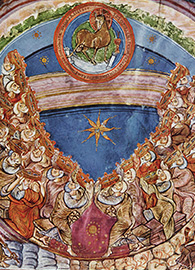Revelation Week 4
The Lamb Alone is Worthy to Open God’s Scroll (Revelation 5)
By Rob Wall
Seattle Pacific University Paul T. Walls Professor of Scripture and Wesleyan Studies
Read this week’s Scripture: Revelation 5
18:58
Podcast read by Carla M. Wall

 Enlarge
Enlarge
Revelation 5 reintroduces Jesus Christ as a lamb. By the estimation of most, a lamb is an odd way of speaking of God! I suspect we have far less difficulty placing God on heaven’s throne than we do worshiping a slaughtered lamb. I recall growing up in eastern Washington when there were still ranchers who tended to flocks of sheep. Although the days of the “sheep wars” over grazing rights were the distant memory of a wild west, cattle ranchers continued to ridicule sheepherders as a lowly lot, drawn to messy, un-American animals hardwired to follow the sheep in front of them, even when it was not a good decision to do so! Sheep march in lockstep to slaughter, for example; if one sheep jumps over a cliff, lambs will surely follow to their death. Not always good business, being the lamb.
In Iceland, however, there exists a strain of sheep known as “Leadersheep.” Leadersheep are highly intelligent animals, bred with the instinct to lead a flock home during difficult conditions. They have an exceptional ability to sense danger and protect shepherds and flocks when their lives are threatened. It is wise, then, to follow Leadersheep home. Think of Jesus, God’s Lamb, as the divine species of Leadersheep. Hold on to that thought!
The Significance of the Scroll
Recall in the opening Lectio I mentioned that Revelation is written in the literary form of a pastoral letter. Each of the letter’s four parts has an important role to perform, none more important than its main body. The main body of a pastoral letter holds a detailed response to the crisis that occasions the letter. There we find advice and instruction, exhortation and rebuke that put faithful readers to rights. Revelation 5 begins the book’s main section, where the prophet applies the heavenly visions he receives from Jesus to the spiritual crisis (see Lectio 2) at hand. Sometimes, however, the writer inserts a hinge text between the letter’s thanksgiving and its main body on which the letter’s overall thesis then swings. For example, Paul inserts such a passage into Romans 1:16–17, the letter’s thesis statement that is then developed and defended in the main body. Revelation 5 is such a hinge passage, and for this reason most interpreters recognize it as among the book’s most important visions.
The phrase “Then I saw” (5:1) is John’s way of introducing a new scene. He’s still a traveler in heaven’s throne room, and his eye continues fixed on “him who sat on the throne” (5:1). But for the first time the prophet notes a scroll “in [God’s] right hand,” and upon closer scrutiny notes that there is writing “on the inside and on the back” and that it is strapped shut by seven seals (5:1). Although John surely expects his hearers to capture the importance of this document, no commentary of its importance is given. Several, however, have been offered by others during the history of Revelation’s interpretation.
Two observations about the scroll itself must guide us. First, a two-sided scroll is odd, since most would want to protect its contents by placing the writing on the inside only. The number seven symbolizes something complete or finished; whatever is written and sealed shut inside the scroll is a complete or finished literary product. Second, the one who holds it has just been identified and praised by the heavenly host as the Creator who alone establishes the existence and purpose of every creature (4:11). Remove the chapter headings, which later scribes inserted to pace our reading of Scripture. John expects the hearer of Revelation to connect the doxology of 4:11 with the scroll of 5:1. That is, the scroll contains God’s complete and final plan for putting a broken and battered creation to rights.
The One Who is Worthy to Open the Scroll
But there is a problem, and it concerns the protocol for hatching God’s plan of salvation. Ancient hearers may well have recognized this scroll as an imperial document whose importance is signified by the enthroned Caesar’s seven seals. They would have known that such a document written on parchment would not have been enacted until the seals were broken by someone authorized by the ruler to do so, and then read aloud. Put simply, God’s comprehensive plan to save creation from death is initiated only when someone authorized to do so breaks open the sealed scroll and publishes its happy contents. [Author’s Note 1]
But the abject terror of not finding that special someone is clearly realized in the next snapshot of John’s vision: the angel dispatched to find someone “worthy to open the scroll” fails to do so (5:2–3). And this angel’s profile is impressive: it is “mighty” and is “proclaiming” [Author’s Note 2] the search in “a loud voice” (5:2). Moreover, even the scope of its search is as comprehensive as the Creator’s redemptive plan: no nook or cranny of creation is left unattended by the powerful angel’s failed quest of that worthy someone (5:3). And so even the prophet enters his visionary world to weep and weep some more (5:4), tears shed in desperate recognition of a hopeless situation: if no one worthy is found, the scroll will remain closed and its precious contents forever unrealized.
In a stunning reversal — one of the most emotionally powerful moments in all Scripture — a dispirited John is tapped by one of the heavenly elders (see 4:4) and instructed, “Don’t weep! Look!” (5:5). The elder even provides the résumé of whom the prophet is about to see: someone who is worthy to open the scroll and get God’s salvation show on the road! His credentials are indeed impressive: he is “the Lion of the tribe of Judah,” destined to rule the nations (read Genesis 49:8–12); he is “the Root of David” (who is from Jesse’s root), whose victory vindicates the faithful (read Isaiah 11:1–16; cf. Revelation 3:7). Surely such a magnificent and powerful ruler is well suited to broker the victory of God.
Jesus the Lamb
But in another great reversal, equal to the first and signaled by another “then I saw,” the prophet does not see the lion promised him; he rather sees “a Lamb standing as if it had been slaughtered” (5:6). In John’s visionary world, the Lion is not replaced by the Lamb, but the one is rather morphed into the other — a morph picked up by the dramatic tension of the image of a Lamb “standing as if it had been slaughtered.” John’s sighting is of a slaughtered Lamb that is alive and standing, victorious over death! Judah’s promised Lion is none other than God’s risen Lamb.
Bible students are alert to the theological importance of slain lambs. We know in particular the Passover lamb whose shed blood identified God’s people, who exchanged death in Egypt for freedom in the Promised Land. According to John’s apostolic tradition, Jesus is the divine Passover Lamb whose sacrifice on the cross takes away the sin of the world once and for all (John 1:29; 19:31). [Author’s Note 3] Israel’s messianic Lion is also God’s paschal Lamb for the nations.
The Lamb is the dominant metaphor for Jesus in Revelation, used twenty-eight times in a variety of settings. But its introduction here must be kept in mind wherever else it is found in John’s visionary landscape. Here the slain Lamb morphs again into more familiar images of worth, which explains why he becomes the center of the heavenly community’s worship: the repetition of “seven,” symbolic of something complete, is applied both to “horns” and “eyes” (Revelation 5:6), which John explains represent God’s sevenfold Spirit.
The first image, “horns,” probably is figural of a reversal of power: the slaughtered Lamb has become the standing (i.e., risen) ram whose seven horns suggest that his power is vast and complete. [Author’s Note 4] The belief layered into this image, then, sings the same lyric as Paul’s hymn of the obedient Christ, whose sacrifice of his preferential option of deity to die on the cross leads to God’s appointment of him as Lord over all creation (Philippians 2:4–11; cf. Acts 2:36). The Lamb’s “eyes” are those of God’s Spirit (cf. Zechariah 4:10; Revelation 4:5), which indicates that his lordship over all creation is rooted in an intimate awareness of what is happening on the ground. The living Jesus is hardly a detached, remote Lord, but one who is fully alert to the world’s condition.
Worship and Prayer: the Response to Redemption

 Enlarge
Enlarge
The next event John witnesses is arguably the most important of any he sees: the Lamb, whose worthiness is indicated by his sevenfold horns and eyes, steps forward and takes the scroll from the Almighty One’s right hand (5:7). [Author’s Note 5] He alone is worthy to do what no one else can: take the scroll — which sets out God’s comprehensive plan of creation’s restoration, break open its seals (5:9), and publish its glad tidings of great joy. And heaven’s response is immediate: weeping turns into worship!
The first worship practice is to bow in faithful submission before the Lamb (cf. Revelation 1:17) as this same heavenly company had before God (4:8–10). Except for the Psalter, there is no book of Scripture that concentrates us on the practice of worship more so than Revelation. Worship is thematic of Revelation. And there is a good reason for this. In John’s world, as in our own, the worship of the creature — whether the Roman Caesar or household idols — is substituted for the worship of the Creator. The rejection of idolatry, which locates power or security in something other than God, is clear in Revelation. God alone is worshiped because God alone, who created all things and by whose will all things exist, is worthy of our worship (4:11). What is remarkable about John’s vision is that Jesus, the victorious Lamb, is not only included in this act of worship but joins the enthroned one and the sevenfold Spirit at its center. This book is the most decisive witness to the triune God in Scripture. [Author’s Note 6]
But there’s work to do: the elders and living creatures come before the living Lamb with prayers and harps. Their prayers are those “of the saints” (5:8); they mediate or represent our petitions before the heavenly throne. They bid saints (i.e., Christians) to pray “in Jesus’ name” as an act of worship due only to God. But our prayers participate in his victory over death as the mechanism of creation’s restoration. We are motivated to pray, then, not only as an act of submission to the Lord’s authority but with the realization that to pray according to God’s will prompts God to meet our requests since by doing so we already are participating in God’s promised healing of creation.
Harps in Revelation always cue singing. The lyrics of the “new song” that the heavenly chorus sings (5:9–10) explain why Jesus is worshiped as God. This is a doxology in celebration of redemption: “persons from every tribe, language, people, and nation,” (cf. 5:9; 7:9; 10:11; 11:9; 13:7; 14:6; 17:15) owe Jesus their salvation, which he did as an act of obedience “for God” (5:9) (and not for us lest we humanize Jesus’ sacrifice as something other than an agreement of the triune God). [Author’s Note 7] But this salvation received from God also establishes the future of God’s people as “a kingdom [of] priests” who will participate in God’s heavenly rule come to earth (5:10).
This is an Exodus hymn, apropos of the paschal Lamb. When Israel’s God meets with Moses on Mount Sinai following Israel’s great escape from Egypt, God says to him that God has brought this people out of slavery as “my treasured possession out of all the peoples” (Exodus 19:5) in order to become “for me a priestly kingdom and a holy nation” (Exodus 19:6). The church’s story is Israel’s story: the Messiah has made good on God’s promise to Moses.
While the lyrics of the new song may lead in the worship of the Lamb’s functional deity — i.e., as the worthy one who sacrificed himself for God to bring all humanity the promised salvation from God — John now clearly envisions the eternal essence of his deity: the slain Lamb is properly worshiped by heaven’s company for who he is (Revelation 5:11–12). What a magnificent scene John hears and sees: millions of angelic voices are added to the elders and living creatures, who surround the throne in glad crescendo to sing creation’s doxology of who the Lamb is, calling to mind the first verse of the Wesleyan hymn, “O For a Thousand Tongues to Sing.”
O for a thousand tongues to sing
My great Redeemer’s praise,
The glories of my God and King,
The triumphs of His grace!
(Charles Wesley, 1793)
Initially seven characteristics are recognized — not as credentials of the Lamb’s worth but as qualities of his full-bodied (i.e., sevenfold) divine nature (cf. Revelation 4:11): power, wealth, wisdom, might, honor, glory, and blessing. Each characteristic is associated with God in Scripture; but what strikes one as more crucial to their meaning here is that several are also linked to social class or political influence. Especially for a church whose most faithful membership exhibits the material costs of discipleship (cf. 2:9) or a church whose hypocrisy testifies to its spiritual poverty (3:17), this characterization of the living Lamb is a sharp reminder of the qualities of faithful discipleship.
A refrain, linked to 5:12 by the word “blessing” (literally, a “good or true word,” cf. 7:12), is sounded in 5:13 that implicates the Creator’s plan to restore creation with the Lamb. Not only is the Creator worthy to receive “glory and honor and power” (4:11), but so is the Lamb to whom “honor and glory and power” also belong. They are of a piece in both person and in the work of the new creation, and so are worshiped together. The sounding of the “Amen” (5:14) brings this heavenly liturgy of worship to a close and prepares us for Revelation’s next scene.
Questions for Further Reflection
- Where is the Holy Spirit in the midst of worship?
- What is it that occasions the outpouring of worship?
- When and how does our submission become worship?
<<Previous Lectio Back to Revelation Next Lectio>>

This work is licensed under a Creative Commons License.




